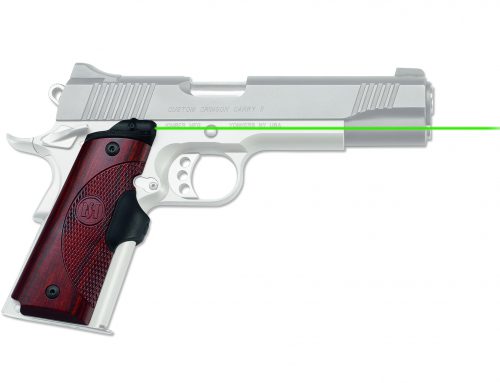I always thought I was pretty handy, at least until today. Then I got humbled.
You see, I had the opportunity to build my very own Crimson Trace LG-401G Lasergrips for a 1911 pistol. I was visiting the Crimson Trace factory in Wilsonville, Oregon, just south of Portland, and those crazy folks seemed to believe that even a klutz like me could make something high tech like a four milliwatt green instinctive activation pistol laser. But they didn’t have enough faith in my technical ability to turn me loose on the factory floor unsupervised.
Tong was the engineer who humbled me, but he was really nice about it. He let me make some mistakes, then gently corrected my little messes while teaching me the right way to do things. I actually worked with Tong on two sets of grips. He built the first set, while carefully instructing me on the intricacies of each step in the process, and there were a lot of them – 13,729 I think, but who’s counting? I then took the drivers seat and started on the Lasergrips that I would build, then take home with me, to install and use on one of my 1911s.
Making your own Lasergrips is easy. In fact, pretty much anyone can do it. Just assemble the following tools and facilities, then we’ll walk through the process together here. Go ahead, I’ll wait til you’re ready.
An armory
I’m assuming you have more than one gun, so you’ll need at least a dozen guns of each type for the laser you want to design and build. Some of them will be used for performance testing. You see, a laser has to be built to absorb massive g-forces of recoil in the x, y and z axis – tens of thousands of times. Oh, the grips and electronic components inside have to deal with rotational forces also. You’ll wear out a few guns until you get the laser and interior components design just right.
Some of the guns you’ll need to chop apart into pieces. This is the part where you and I both cry. Chop up perfectly good guns? Yep, it’s all for the cause. See, when you assemble the grips, you’ll want to do it on the actual gun frame you’re making the laser for, not a copy that might have slight dimensional variances. The best way, how Crimson Trace does it, is to chop off the grip end of the frame of an actual gun to make construction jigs. Of course you’ll need to make multiple sets of these so you can meet the required production volume.
An indoor shooting range
You’ll want to install an indoor shooting range, hire an armorer to keep all the guns in the armory running, then train staff members to perform the hundreds of thousands of rounds of live fire testing. Believe it or not, there will be too much shooting for just one person to handle. Don’t forget to install lead management ventilation systems – and soundproofing so you don’t tick off the neighbors.
An engineering testing lab
If you’re going to do it right, you need testing facilities in house for non-shooting performance testing. You’ll need electrical testing equipment to make sure your battery and power management designs are up to par. You’ll also need moisture and immersion testing equipment, because a laser on a gun wouldn’t be of much use if it stopped working when it got a little wet. Don’t forget environmental testing equipment. Your Lasergrips will need to perform in exceptional hot and cold conditions. Not only environmental temperature changes, but operational temperature changes. Guns get hot when you shoot them a lot.
A collimation lab
Direct green laser diodes are a raw material that need to be directed, tuned and tweaked before they’re capable of projecting a neat green dot on target. After you line up your German diode supplier, you’ll need to construct special housings and install the diodes in them so they don’t get smashed to bits by recoil. Oh, and you’ll need to design an adjustable lens that takes the broad, rectangular green light output of the diode and focuses it into a sharp dot at a range of 25 feet. For this application, you can do what Crimson Trace does and construct mirror mazes, so you can focus each and every diode in a smaller space because you’re bouncing the beam out and back via the mirrors. Distance is distance, regardless of how many turns there are.









Leave A Comment